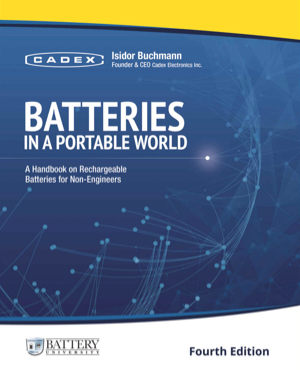An electrochemical battery consists of a cathode, an anode and electrolyte that act as a catalyst. When charging, a buildup of positive ions forms at cathode/electrolyte interface. This leads electrons moving towards the cathode, creating a voltage potential between the cathode and the anode. Release is by a passing current from the positive cathode through an external load and back to the negative anode. On charge, the current flows in the other direction.
A battery has two separate pathways; one is the electric circuit through which electrons flow, feeding the load, and the other is the path where ions move between the electrodes though the separator that acts as an insulator for electrons. Ions are atoms that have lost or gained electrons and have become electrically charged. The separator electrically isolates the electrodes but allows the movement of ions.
Anode and Cathode
The electrode of a battery that releases electrons during discharge is called anode; the electrode that absorbs the electrons is the cathode.
The battery anode is always negative and the cathode positive. This appears to violate the convention as the anode is the terminal into which current flows. A vacuum tube, diode or a battery on charge follows this order; however taking power away from a battery on discharge turns the anode negative. Since the battery is an electric storage device providing energy, the battery anode is always negative.
The anode of Li-ion is carbon (See BU-204: How do Lithium Batteries Work?) but the order is reversed with lithium-metal batteries. Here the cathode is carbon and the anode metallic lithium. (See BU-212: Future Batteries) With few exceptions, lithium-metal batteries are non-rechargeable.

The cathode of a battery is positive and the anode is negative.
Tables 2a, b, c and d summarize the composition of lead-, nickel- and lithium-based secondary batteries, including primary alkaline.
| Lead acid | Cathode (positive) | Anode (negative) | Electrolyte |
|---|---|---|---|
| Material | Lead dioxide (chocolate brown) | Gray lead, (spongy when formed) | Sulfuric acid |
| Full charge | Lead oxide (PbO2), electrons added to positive plate |
Lead (Pb), electrons removed from plate | Strong sulfuric acid |
| Discharged | Lead turns into lead sulfate at the negative electrode, electrons driven from positive plate to negative plate. |
Weak sulfuric acid (water-like) | |
NiMH, NiCd | Cathode (positive) | Anode (negative) | Electrolyte |
|---|---|---|---|
| Material | Nickel Oxyhydroxide | NiMH: hydrogen-absorbing alloy NiCd: Cadmium | Potassium Hydroxide |
| Lithium-ion | Cathode (positive) on aluminum foil | Anode (negative) on copper foil | Electrolyte |
|---|---|---|---|
| Material | Metal oxides derived from cobalt, nickel, manganese, iron, aluminum | Carbon based | Lithium salt in an organic solvent |
| Full charge | Metal oxide with intercalation structure | Lithium ions migrated to anode. | |
| Discharged | Lithium ions move back to the positive electrode | Mainly carbon |
| Alkaline | Cathode (positive) | Anode (negative) | Electrolyte |
|---|---|---|---|
| Material | Manganese dioxide | Zinc | Aqueous alkaline |
Electrolyte and Separator
Ion flow is made possible with an activator called the electrolyte. In a flooded battery system, the electrolyte moves freely between the inserted electrodes; in a sealed cell, the electrolyte is normally added to the separator in a moistened form. The separator segregates the anode from the cathode, forming an isolator for electrons but allowing ions to pass through. (See BU-306: Separator and BU-307: Electrolyte)

Comments
Looking for comments from the previous website?
Comments from the previous website are not compatible with our new commenting system but we have preserved them so our users can still reference and make use the information in them.
